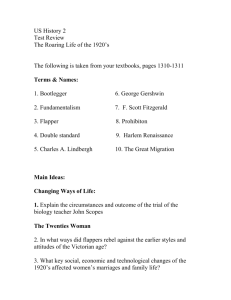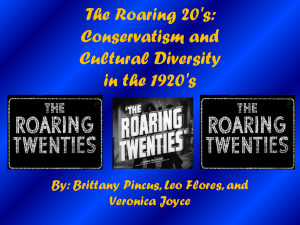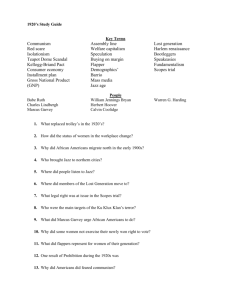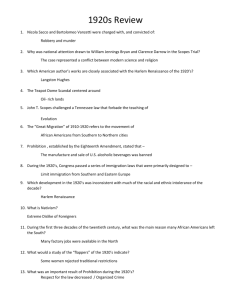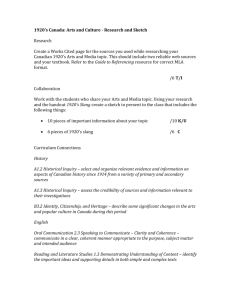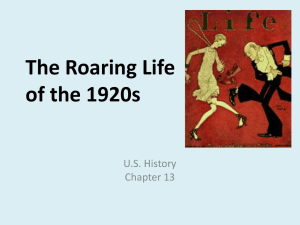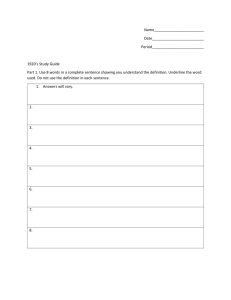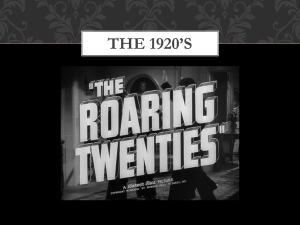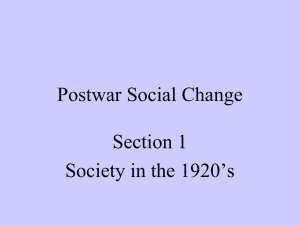1920`s McGuire`s US II Class Notes
advertisement
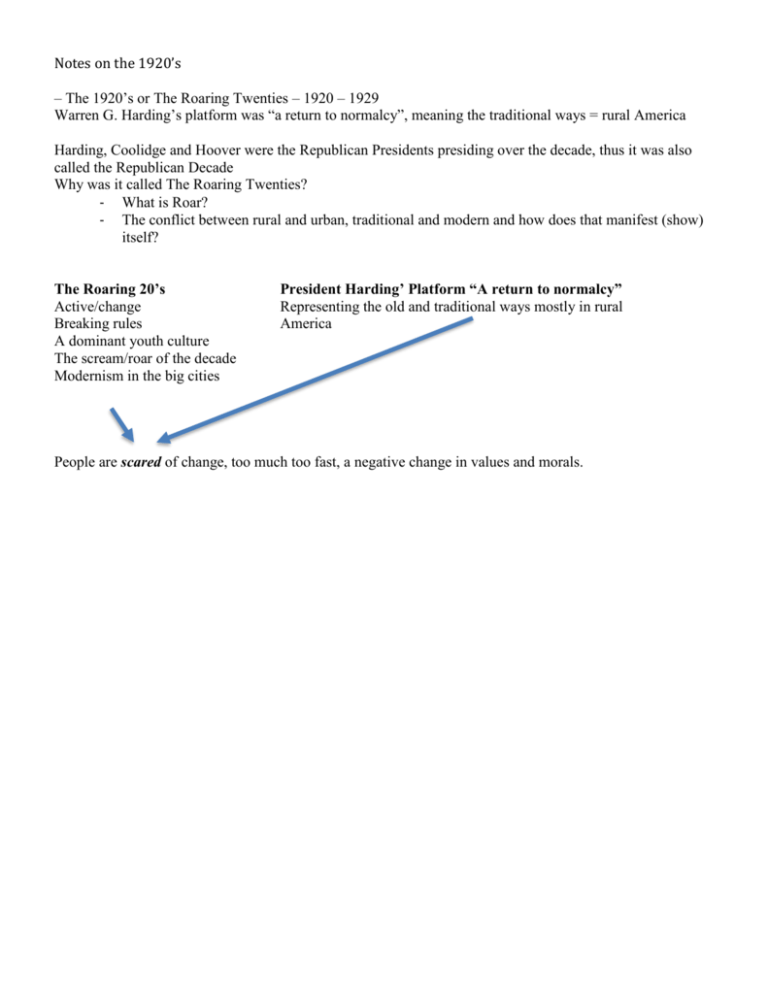
Notes on the 1920’s – The 1920’s or The Roaring Twenties – 1920 – 1929 Warren G. Harding’s platform was “a return to normalcy”, meaning the traditional ways = rural America Harding, Coolidge and Hoover were the Republican Presidents presiding over the decade, thus it was also called the Republican Decade Why was it called The Roaring Twenties? - What is Roar? - The conflict between rural and urban, traditional and modern and how does that manifest (show) itself? The Roaring 20’s Active/change Breaking rules A dominant youth culture The scream/roar of the decade Modernism in the big cities President Harding’ Platform “A return to normalcy” Representing the old and traditional ways mostly in rural America People are scared of change, too much too fast, a negative change in values and morals. Major theme of the 1920’s – the conflict between the traditional and modern It is about crossing the line and breaking boundaries – socially, politically and economically It is the birth scream of the modern. ABC Video ‘The Century’ 1. Prohibition – the 18th Amendment – bans the production, transportation and consumption of alcohol. The Amendment has an adverse affect, it increased crime and gang violence. People made their own alcohol and went to speakeasies, underground illegal bars, where everyone risked being arrested. Gang violence grew out of battle for liquor territory. 2. Urban Society – and ‘the birth scream of the modern’. By 1925 more people lived in the cities/urban areas than lived in the rural countryside. The rise of the skyscrapers exemplifies our need to grow upward and symbolized our nations power. People are drawn to NYC, and for the first time in history the population of the cities is greater than the countryside. a. Bdway – the best talents of entertainment b. Madison Ave – advertising and unifying the nation is a series of shared beliefs and desires coast to coast. c. Wall Street – shows the expanding economic opportunities, stock market boomed. d. Park and 5th Aves – is where the millionaires lived. They held parties, entertained and shared in each others lavish lifestyle 3. Harlem Renaissance – An explosion of music, writing and pride in African American Culture and Politics, Harlem was the Promised Land for many AA’s in America. a. The Idea of the ‘New Negro’ is born, proud to be black and standing up for black culture and literature. b. Marcus Garvey stated: “Black is Beautiful”, and created the ‘back to Africa’ movement. c. There is a growing demand for equality as seen through the arts, music and literature. Jazz – new style of American music explodes in Harlem. Louis Armstrong, Bessie Smith and Duke Ellington are the leaders of the Jazz Age. Harlem was also a hot bed for literature, ideas, politics and music. d. Lots of nightclubs open in Harlem, most notably the Cotton Club which was segregated. Ironically the bands and performances were black and the audiences were white! 4. The Lower East side represented the ‘gateway’ for many eastern European immigrants. NYC becomes more racial diverse with its people, business and manufacturing. Immigration – many eastern European immigrants settled in the tenement housing of the lower east side of Manhattan. Europeans came to America because their nations were destroyed by war in WWI. 5. Cultural – People in the big cities were willing and trying to get away from the traditional, the old, and wanted to embrace the ‘new’. New architecture (skyscraper), new music (Jazz), new styles of fashion (Flapper) and ideology (thinking – Darwinism). 6. Technology – a. Electricity gave way to all types of appliances and light! i. Cities had electricity for the first time, which allowed the day to be extended leading to ‘nightlife’. b. The Car revolutionized how people lived, spent social time and allowed for freedom. i. The government started developing its infrastructure of roads and bridges. ii. Roadside advertising grows and creates iii. the Car changed the way we think about the space we live in. People left their homes and traveled. c. The Radio made its appearance around 1920, by 1929 nearly everyone had a radio. i. First radio station KDKA Pittsburgh, PA. ii. It was communal exercise, an experience that we all shared simultaneously 7. The idea of Credit was new –buy now pay later. Everything could be bought on credit; cars, radios, appliances. People often overextended themselves with having too much credit, this is one of the underlying causes people experienced personal bankruptcy prior to & during the Great Depression. People were able to buy appliances and cars for the first time and all on credit. 8. Advertising was a growing a field and Madison Ave. created a uniform experience throughout magazine, billboard and movie ads for the public. 9. Women – 1920 – the 19th Amendment granted women the right to vote!! The Flapper emerges – young women break the gender rules of how a women should ‘act’. Women wore shorter dresses and hair, smoked and drank in public, went to parties. Flappers smashed the gender roles and pushed the limits. They didn’t want to dress like their mothers, with long dresses, long sleeves and high collars. The Flapper wore short skirts, deep neck lines, cut their hair short, smoked, drank and simply partied with friends. 10. Rural America – People still lived as their parents and grandparents did, farming old ways and living traditional lifestyles. These rural folk felt that the big city ways and ideas were infecting them, and didn’t readily accept the new ideas, styles, language and behavior of their young people. The Monkey Trial – John Scopes was charged for teaching the ‘theory of evolution’ in public school. Pitting religious followers of the bible and modern thinkers against each other. New vs. old. “It was one thing to replace the family mule with the Model T, but another to replace Matthew, Mark and John with Einstein, Freud and Darwin”. People were fickle they wanted both the benefits of the modern world, (electricity, cars and appliances) but they also wanted the comforts and familiarity of the old world. a. Rural folk lived much the same way they had for hundreds of years. Life was simple, slow, pleasant and was guided by a strong work ethic backed by religious beliefs. They had no electricity, few appliances and no worries about the city life. However, the country folk worried that the bad influences of city life was threatening. New thinking, deviating from traditional thought and not observing the ways of the religion would be considered unpopular and rude. 11. Harlem Renaissance – a rebirth or reawakening of African American art, culture, literature often with a political view or message. The idea of the ‘New Negro’ is born, Marcus Garvey states ‘Black is Beautiful’, to be proud of your African American heritage. 12. Many People wanted the fruits of the modern world but were conflicted because they also wanted to keep/hold onto the old world beliefs. This created a psychology tension between nativists, many white Americans, against foreigners and any other people that threatened their way of life. This leads to a huge rise in KKK membership. 13. The KKK rose to prominence – many Americans didn’t welcome the fast pace of progress and took their frustrations out on foreigners, immigrants, Christians, Jews and blacks. The KKK grows, lynching occurs and they gain political control in several Southern states. 14. Heroes – Babe Ruth, Lou Gehrig Charles Lindbergh, Amelia Earhart. Breaking records: Charles Lindbergh flew solo from NY Paris, he achieved international success and a ticker-tape parade in NYC for him. It seemed that the whole western world was waiting for news. What he accomplished was another step for Americans, believing that nothing was unachievable, the boundaries were endless for humans. All these events captivated the nation and were broadcast by the new invention of the radio. These events brought the country together at times; people in the Midwest could hear a Yankee game live! How did WWI influence/encourage the Harlem Renaissance? - The lack of recognition after the war made AA work a little bit harder for recognition - AA were facing racism by other American troops but were recognized and awarded by the French government for their fighting in WWI. - The Great Migration – southern AA were now living in northern cities, this allowed them to share their ideas, thoughts, music, art and literature. - Jazz music is like by many whites opening up doors of appreciation for their music. Arts/Culture – Music and poetry Politics – W.E.B. DuBois NAACP immediate integration into society, we fought for democracy in Europe and we’ll fight for democracy at home. Marcus Garvey – new, radical, Jamaican born. He creates the ‘Black is Beautiful’ idea – the idea of acceptance of your own culture, heritage and history, which is generally accepted. Garvey creates UNIA – Universal Negro Improvement Association – this is where the idea of the ‘New Negro’ is born. Begins the ‘Back to Africa’ movement, the idea of getting blacks to leave America and go back to Africa. Why stay in a country that doesn’t want you, that doesn’t believe in integration. Back is Africa is not widely accepted. Prohibition and the 18th Amendment Morality Do we follow the law? Can government regulate morality? It was a ‘noble experiment’ Women Social equality ? Legal equality ? Desire to break with the past Dating and relationships Dating and relationships Nativism Immigration issues Is it good or bad? Economics Brewers go out of business and the working class guy looses his job Presidents of the 1920’s Warren G. Harding* 1921 – 23 (dies in office) Calvin Coolidge 1923 – 29 Herbert Hoover 1929 – 1933 These Republican Presidents promote deregulation of big business – a type of Laissez Faire policy. Much of the success in the 1920’s success masked the corruption that was happening, which lead to the crash. (Secretary of the Treasury under all 3 President was Andrew Mellon, he will become important when we look at the causes of the stock market crash and ensuing Depression) 1920’s – the Republican Decade *Harding’s platform was a ‘Return to Normalcy’ in that he meant the following; - To return to a time before the Progressive Era and the Age of American Imperialism. Harding is referring to the time called the ‘Gilded Age’ - A time of higher morals and a conservative attitudes - What grows during this decade are the following: o A rise of Nativist attitudes/beliefs, immigration restrictions and quotas. o The wealthy/big business are influential in pushing for laissez faire and deregulation. Foreign Policy In the 1920’s – Isolationism - We declare our isolationism – to be left alone - The US does not join the League of Nations - The Washington Naval Conference* – the big nations of the world limited their tonnage of naval ships to stop militarism in hopes to avoid future war - Kellogg-Briand Pact, it (seriously) tried to outlaw war - The Good Neighbor Policy with Latin America by removing US troops from SA. We will be less involved in Latin America o This policy repudiated (disown or take back) the Roosevelt Corollary - The US is reducing the size of the Army at home - Immigration Restriction & Quotas o US only allowed a small % of each ethnic group/nation allowed into US each year. o This policy is fueled by nativism = the idea that Americans want America for Americans. There is a growing fear of the foreign born. o The Economics of the 1920’s – back to the Gilded Age “The Business of America is Business” President Harding open’s the decade on the platform of a “Return to Normalcy” harkening back to the feeling of the Gilded Age. 1. Laissez Faire literally means ‘hands-off’ of business leads to deregulation and a Government that is hands-off with big business. This deregulation leads to problems and corruption. a. Lessens the power of government, the ICC and anti-trust laws. 2. Credit (what is credit? Simply put, it is borrowing money) a. Individually w/ average Americans – this is the beginning of buying on installments, lay-away or a type of payment plan. b. Nationally – The government at this time does not believe in going into debt to pay bills or for programs, known as deficit spending. The US government is operating without a deficit and wants its loans from European countries ASAP!!!! c. Internationally – The US and its top economists create The Dawes Plan* (see below) i. By getting involved with the finances of foreign countries we split from our policy of isolationism. We are tying ourselves to the world economy. 3. The Stock Market is booming throughout the 20’s and is largely unregulated. 4. High (protective) Tariffs1 in order to protect American made goods. a. The Fordney-McCumber Tariff is passed, raises taxes to the highest levels in history. It is a tax on imports, which is a protective Tariff, to help protect American businesses. b. The Smoot-Hawley Tariff also raised tariffs on other imported goods. c. 1Tariff is a tax on imported goods d. In turn the government is able to lower Income Taxes in the USA 5. …Trickle-Down Economics – a. The idea is to lower (or cut) income taxes on the wealthy and big business. i. When you lower taxes on this group the theory is that big biz will hire more people and expand wealth and employee income and the wealthy will spend more $$ on luxury goods and services and money will trickle-down to the rest of us average folk. ii. In Theory, this should lead to job creation, higher wages and more demand of goods, all of which would help the middle/working class, however…. b. …*what actually happens is big businesses gives themselves bonuses, invests the $, saves it, modernizes their factory or sets the $ aside for a rainy day. 6. In the USA Industrial Production grows dramatically as does our GNP a. Americans, for the first time have Disposable Income – money to spend on leisure time or fancy appliances b. Part of the success of the American worker is the rise and power of labor unions of the 1910’s, but during the 1920’s labor unions are seen as Socialist ideas and membership declines. c. Consumerism rises partly through the pressure/influence of advertising and by the development of credit, which is the installment plan/lay-away. 7. The Federal Reserve System, there is little to no regulation of banking. The FED was weakened in terms of its power of controlling banking and loans. This leads banks to make risky loans to unqualified buyers.
